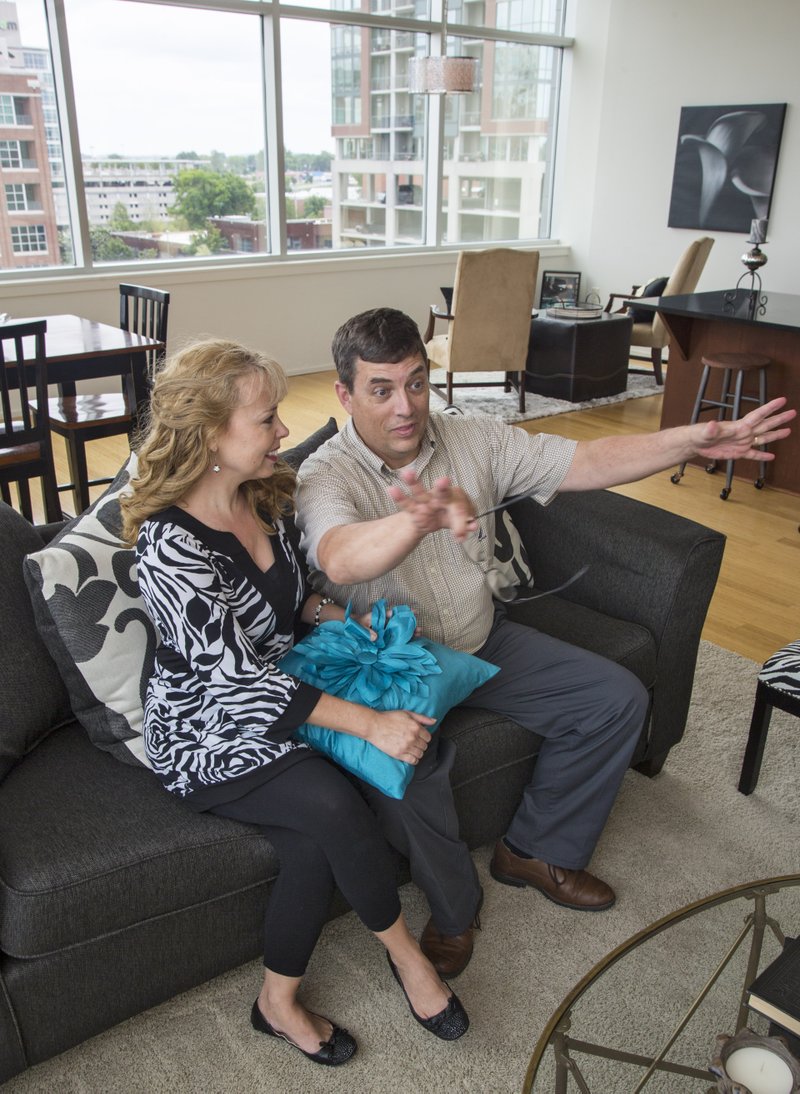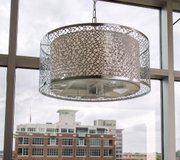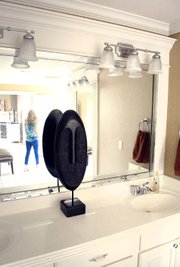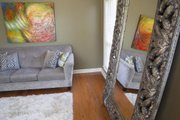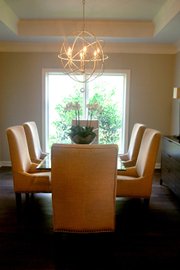Dana Baggett, a home stager who has owned the Little Rock franchise for Showhomes Inc. since 2014, is hosting a broker's open house for real-estate professionals at a Maumelle house she staged.
The house looks like those finished-product houses on HGTV's renovation shows: It's inviting without being too personal ... or too cluttered.
A sleek, white sectional sofa dominates the open-concept kitchen and great-room area. The sofa is accented with red pillows; a round, studded, red-framed mirror over the fireplace is positioned near mirrored shelves on the wall. At the bottom of the staircase, a bookcase is sparsely and efficiently appointed with books -- placed upright and horizontally -- and a colorful knickknack or two. The bookcase faces a dramatic, contemporary, oil-rubbed-bronze-colored, wall-art piece.
In the living room, a plush gray sofa is placed below a soothing abstract painting. A massive, ornate silver-framed mirror and bright green accent pieces help to finish the room. The dining room, upstairs bedroom, the baths and a sitting/media room exude the same calming, eclectic elegance, impersonal and inviting.
All these touches are designed to appeal to potential buyers and help them envision their own belongings in the house.
Staging a house -- a process in which a professional draws from furniture he keeps in inventory, moves that furniture into an empty house and arranges it to help buyers better envision living there -- has become a popular option among home sellers and real-estate professionals.
Statistics from the Real Estate Staging Association reveal that staged houses sell 73 percent faster, on average, than nonstaged ones. An association study of 1,081 houses revealed that those not staged first spent an average 184 days on the market; after staging, they sold in an average of 41 days. Houses staged in the first place sold on average in 23 days.
"If you stage it on the front end, it generally will sell quicker," says Debbie May of The House Staging Co. in Little Rock. "To make a little money, you have to invest a little money."
Staging is several decades old but hasn't caught on here until the last four to five years, May says.
A former antiques dealer who has done interior design work, May has been a stager for a little more than four years. Business started out a bit slow, but didn't stay that way for long.
"Probably the first three years, it doubled every year," she says.
Last year, the market itself was a little slower, but it is off and running for her again in 2016. Normally, things slow down at the end of one year and pick up in February or March of the next.
"This year it picked up the second week in January and it has not stopped," May says. "It has been just wild."
Seeing the vision
Why is home staging so popular? And why is it so useful?
Baggett likes to use this example.
"They invented color books for a reason," she says. "You give a little kid a blank piece of paper; he's going to scribble. Well, basically, a lot of people 'scribble' with their furniture. And when I come in, I'm the color book. I'll give them a basis of what their furniture could look like in this house, and they say, 'Oh, yeah, I think my couch would look good right there,' or something like that. And so I'm the outline that people can follow when they're looking at a house to buy.
"Otherwise, they're coming in, they're looking at a bowling alley sometimes ... this empty room. And they think, 'Oh, no, my furniture won't fit there. My furniture is too small. My furniture is too big.' Because they can't get that spatial visual. So we help with that. And plus, we keep it clean and keep out the bugs and keep the utilities on a nice temperature."
Nola Ford, an executive broker with Crye-Leike, has been in real estate almost 18 years. She began working with Showhomes just this year and says she will "definitely" continue to incorporate staging into her efforts to sell her clients' houses.
"I think it's awesome," Ford says. "People walk into a vacant house and it's like they can't really tell how big the room is, whether their furniture would fit. But once they see this couch in here, they know their furniture's going to fit in here."
Jacquelyn Twillie of Twillie Realty has staged clients' houses herself using her personal belongings, and relies heavily on internet photos of these staged houses. "I would suggest people ... use professional stagers. ... Some people just have that ... natural gift to know what goes in that place and what goes in that place. Staging is so important."
And staging is different from interior design, May says.
"With interior design you're trying to fill [houses] up," she says, while in staging you're trying to pare them down, depersonalize them.
Broad appeal
That being said, staging is generally done in neutral colors such as gray and beige, "just because most people like those," May says. "Anybody can move into that color."
It's also normal to use furniture styles that will look good in any home, May adds. "Our furniture is what I call transitional. And it's real easy to go either way. ... We don't do hard contemporary, but it goes a little more modern. But it has some of the traditional lines to it."
It's all about appealing to the majority of buyers. Because people generally don't have the time or the desire to paint the house themselves, they want the house move-in ready, May says.
Baggett will add one major color to her neutral palettes. She has an inventory of blues and greens, and in certain houses she'll combine these with beige or gray. Then she has an inventory of red items -- pictures, accessories, throw pillows. She has her yellow pieces, as well as black and white. "I look at the house and I look at the features and then I determine what's in my inventory, what will look best in this house."
Although impersonal, those staged houses look so good that sometimes the buyer -- or even the seller -- wants to adopt the look. Stagers will help with that, too. If a buyer or seller falls in love with a piece of Baggett's staging furniture, "we'll sell it to them," probably at a discount.
And there's another option: home manager staging, which Showhomes offers. Home managers are people who own beautiful furnishings, need temporary housing and come in and act as caretakers for staged houses. Home managers currently live in the Maumelle house Baggett has arranged.
For unoccupied houses on the market, staging is about helping buyers get a vision of the lived-in space. For owner-occupied houses for sale, it's about helping the owners rid their homes of any items that might distract potential buyers.
If somebody needs her to bring in lamps, accessories and artwork, May says, she can place these in an occupied house. "We try to repurpose what they have" -- rearrange their furniture, redo and repurpose things to other rooms, "to make sure the traffic flow [is] good. We try to disrupt their lives as little as possible."
More than furniture
In either case, home staging is not just furnishings and accent pieces the stagers will manage. The stager can also manage and subcontract new paint, new flooring, new cabinet hardware, landscaping, even some renovation work.
Decluttering and depersonalization are the first two things that must be done in an owner-occupied house.
"That means taking down personal pictures," May says. "And taking down any kind of recognition plaques. Because what happens is, people come in the house and they get distracted if you have a lot of pictures. They start looking at your pictures and not your house. ... They're trying to figure out who lives in the house and what they do. You've got to take that stuff away."
And the line between collectible items and, well, clutter or downright junk can sometimes be thin.
Baggett remembers a male client who self-staged his house using multiple doilies and multiple small rugs.
"He had little bitty, bathroom size rugs all over the house. It was like, I could jump from rug to rug all over the house and never touch the floor. And I had to tell him, 'It looks like you've got lily pads in your [house].'"
The client had even stuffed candles in doilies which he then placed in wall sconces. Baggett had to let him down easily. "He thought he did such a good job."
It's not cheap to stage a house, but it's not outrageously expensive either. "The best way I say it is ... staging is generally less than 1 percent of the asking price," May says.
Staging on a budget
And there are ways to save money on the service.
"Not every room has to be staged," May says. "Generally we stage what we call the important rooms to which you want to wow them when they walk in the door."
She'll do the entryway, main living area, eat-in kitchen with accessories on the countertop, then the dining room. Most times they'll stage the master, "but the rest of the stuff doesn't make any difference. And if you've got a media room, generally people can figure that part out."
The only other room May stages is a really small bedroom. It will be staged as a nursery or a child's room just to show people a bed can fit in there.
Baggett, who says her average staging job is less than $2,000, concurs.
"If they don't want to do whole-house staging, this is the more economical way to go."
HomeStyle on 06/25/2016
